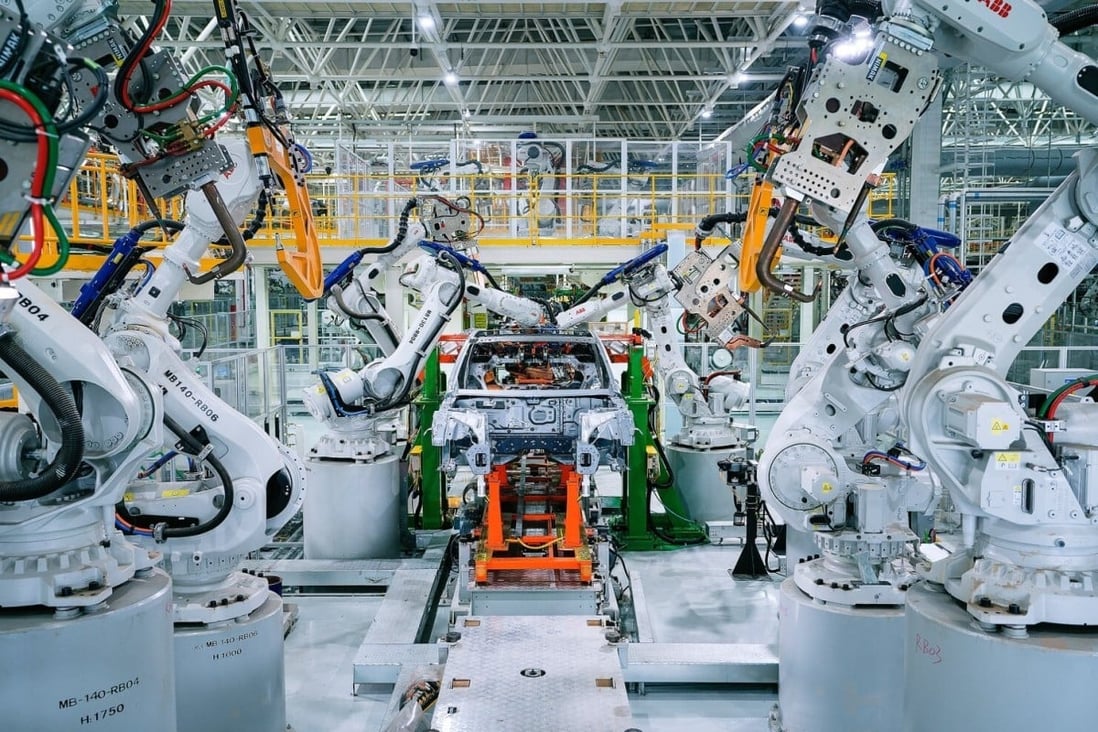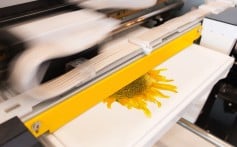China’s factories must be ‘armed with automation’, as coronavirus gives boost to machines in manufacturing
Trade war with US saw many companies relocate outside China, but orders came back last year as Chinese production rapidly rebounded from the coronavirus
Beijing has splashed out huge subsidies on the robotics industry, seeing it as a key element in its push to upgrade the nation’s manufacturing industry
He Huifeng in Guangdong
Published: 10 Jan, 2021

Xpeng’s factory, in the southern Chinese city of Zhaoqing, touts 100 per cent automation in the installation of car bodies at its welding workshops, with more than 200 robotic arms.
\ Photo: Handout
The US-China trade war weakened demand for automation on Chinese assembly lines from 2018-19, but a shortage of manpower during the pandemic reversed that trend last year, and analysts expect manufacturers to further embrace robots in 2021.
“The impact of the pandemic on the global industrial supply chain has been a major stimulus, forcing a huge number of orders to return to China,” said Peng Biao, an analyst with Fashionprint.com, which monitors the fashion industry. “Last year was like a roller-coaster ride for Chinese manufacturers, from huge drops in revenue at the beginning of the year to a huge rebound later that year. And now there is a growing shortage of manpower everywhere, so medium- and large-sized companies are now, again, having to step up the replacement [of workers] with robots.
“For example, among garment printers that survived last year, it can be said that 80 per cent of them have plans this year to invest in automation. Otherwise, it will be difficult to survive in the future, because they would be eaten up by the soaring cost of labour and materials.”
The US-China trade war weakened demand for automation on Chinese assembly lines from 2018-19, but a shortage of manpower during the pandemic reversed that trend last year, and analysts expect manufacturers to further embrace robots in 2021.
“The impact of the pandemic on the global industrial supply chain has been a major stimulus, forcing a huge number of orders to return to China,” said Peng Biao, an analyst with Fashionprint.com, which monitors the fashion industry. “Last year was like a roller-coaster ride for Chinese manufacturers, from huge drops in revenue at the beginning of the year to a huge rebound later that year. And now there is a growing shortage of manpower everywhere, so medium- and large-sized companies are now, again, having to step up the replacement [of workers] with robots.
“For example, among garment printers that survived last year, it can be said that 80 per cent of them have plans this year to invest in automation. Otherwise, it will be difficult to survive in the future, because they would be eaten up by the soaring cost of labour and materials.”
After the trade war with the United States kicked off in July 2018, many Chinese companies – particularly in the Pearl River Delta and Yangtze River Delta manufacturing bases – said they were relocating production lines out of China, fearing the knock-on effect of trade tariffs.
But now, with China being the only major economy to fully resume production amid the coronavirus, domestic manufacturers and overseas buyers are re-evaluating the need for relocation and the importance of maintaining production capacity in China, according to Luo Jun, CEO of the International Robotics and Intelligent Equipment Industry Alliance, a government-backed think tank on smart manufacturing.
China’s manufacturers embrace ‘smart shops’
1 Nov 2020

And if the pandemic continues to impact the production capacity in other major economies in the coming year, there will be a steady and considerable flow of orders coming to Chinese manufacturing, resulting in a robotics boom, he predicted.
Robotics was one of the 10 cutting-edge industries singled out in Beijing’s “Made in China 2025” industrial policy initiative that sparked international controversy and stood at the heart of the Sino-US trade war. While the plan has since been sidelined, Beijing has still splashed out huge subsidies on the robotics industry, seeing it as a key element in its push to upgrade the nation’s manufacturing industry and provide a solution to soaring labour costs amid a shrinking labour force.
In 2018, the number of newly installed industrial robots in China fell 1 per cent, to around 154,000 units. The market continued to shrink in 2019, dripping 8.6 per cent from a year earlier to 144,000 units, according to figures from China Robot Industry Alliance and the International Federation of Robotics.
But there was a sharp rebound in the latter part of 2020.
Even though China’s industrial robot production plunged 19.4 per cent from a year earlier in January and February at the height of the coronavirus outbreak, total year-on-year output jumped 22.2 per cent in the first 11 months of 2020, indicated a swell in demand as the nation’s overall economy rebounded, according to China’s National Bureau of Statistics.
The GG Robotics Research Institute, based in Guangdong province, estimates that there were more than 169,000 new industrial robot installations last year. That total would represent a 17.4 per cent increase over the 2019 figure of 144,000 units given by the China Robot Industry Alliance and the International Federation of Robotics.
And business is looking up for this year.
Dongguan-based Topstar Technology, one of China’s leading intelligent manufacturing integrated service providers, said it expects to add 5,000 clients this year to the 10,000 it had in 2020. According to the firm, it invested 5 per cent of its 2019 revenue into research and development.
China had a “robot density” of 187 units per 10,000 workers in 2019, according to the latest figures from the International Federation of Robotics, up from 140 in 2018 and 68 in 2016. Globally, there were 113 installed industrial robots per 10,000 employees, on average, in the manufacturing sector in 2019, the figures showed.
Government-backed incentives and funding are still the main engines driving Chinese manufacturers to replace humans with robots in industries including pharmaceuticals, medical devices, new infrastructure projects and food processing.
Robotics-enabled automation is the solution to rising labour costs, said Pink Zhang, manufacturing director of TROX Air Conditioning Components (Suzhou), which invested more than 10 million yuan (US$1.55 million) last year to upgrade its automated production lines.
The company’s sales pitch is ambitious, with Zhang saying TROX aims to achieve annual sales growth in the domestic market of 30 per cent starting this year by providing tailored air conditioning solutions for hundreds of hospitals, institutes, airports and commercial buildings across China.
“We understand the importance of automation in fulfilling our goal, especially after seeing the sudden, huge impact of pandemic-induced [transport] lockdowns on freezing staff mobility,” he said. The company is planning to invest at least three per cent of its annual revenue in replacing human labour with robots in the coming years.
An automation boom is also expected in the food-processing sector after Beijing’s call to ensure food security and eliminate food waste.
China’s food security requires local Communist Party members to step up, minister says
7 Jan 2021

“About 20 per cent of the 7,600 rice-processing factories in China have been partially automated so far. The rest all need to be armed with automation in the near future,” said Zhou Ying, chairman of the board at Hunan Hailian Grain and Oil Technology, which produces “flexible polishing devices” for rice processing.
“In the 2000s, my father sent me to study in Europe to prepare to take over the family business. At that time, all rice-colour sorting machines and packing machines were made and imported from the UK, Italy and Japan. Now, domestic suppliers account for over 80 per cent of the market,” Zhou said.
Beijing’s domestically focused economic strategy is proving to be a golden opportunity for Chinese tech firms of their kind, she said.
Financial support for robotics manufacturers and automation businesses at various levels of government – in the form of subsidies, low-interest-rate loans, tax relief, or land rental incentives – is still considerable. Nonetheless, China remains heavily reliant on imports of core robotic parts from Japan and the European Union, according to Luo at the International Robotics and Intelligent Equipment Industry Alliance.
The goal, he said, is to gradually reduce that dependency in the coming years, and that could be expedited “if global demand remains strong and continues to rely on Chinese production capacity”.
This article appeared in the South China Morning Post print edition as: Pandemic boosts use of factory robots
No comments:
Post a Comment